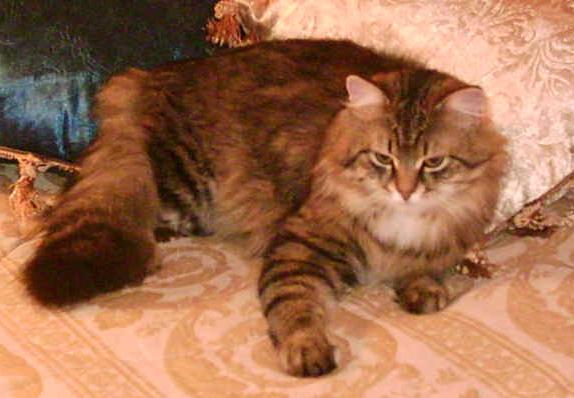Siberian Cat - Breed Profile

Breed Description and Pictures Submitted by:
Regal Siberian
History
- Siberians have been around for at least one
thousand years as far as recorded history. They were first mentioned in
Harrison Wier's book 'Our Cats and all About Them', which included information
about one of the earliest cat shows held in England in 1871. The Siberian is
a natural breed and is the national cat of Russia. breed and is the national cat of Russia.
The Siberian was first imported in 1990. Despite it's
popularity the Siberian is extremely rare in the United States. Most
breeders have waiting lists for their kittens.
The Siberian breed is in Champion ship category since Jan 2007 and no
longer in miscellaneous for CFA and fully recognized by TICA.
One of the largest breeds of domestic cat, the Siberian rivals the Maine
coon and the Norwegian forest cat in size. In fact, the three breeds are
occasionally mistaken for one another because of their similar sizes and
long, all-weather coats. The easiest way to define the differences is to
think in terms of shape. The Siberian has a rounded barrel-shaped torso and
a broad, modified wedge-shaped head with rounded contours, rounded ears and
round eyes. The Maine coon, on the other hand, is more rectangular with his
long body, tail and legs. The Norwegian forest cat has a triangular head,
slanted eyes and pointed ears, and a medium-length body.
Head
 Large, broad modified wedge with gentle rounded contours. Nose is broad
between eyes with narrowing toward tip. Slight concave curvature to nose
profile. Top of head is flat; forehead is domed. Medium in width with high cheek bones. Squareness in muzzle; medium
length nose. Triangular shape which should be as long as broad. Medium to long
wedge-shaped nose. Flat forehead. More of a square profile with the nose a
straight line. Large, broad modified wedge with gentle rounded contours. Nose is broad
between eyes with narrowing toward tip. Slight concave curvature to nose
profile. Top of head is flat; forehead is domed. Medium in width with high cheek bones. Squareness in muzzle; medium
length nose. Triangular shape which should be as long as broad. Medium to long
wedge-shaped nose. Flat forehead. More of a square profile with the nose a
straight line.
Colors and Coats Types Available - The
Siberian, considered a semi longhair, has a rich full coat in the winter
while the summer allows for a somewhat shorter less dense coat. The Siberian
can come in just about every color of the rainbow but because of the rarity
of the breed those colors may not be available in your neighborhood.
Grooming and Care -
Siberians tend to be self-grooming meaning that they remain relatively
tangle-free, though males can and do get 'knotty' in the springtime
Best
Suitable Environment - They are very
active cats with lots of energy but readily adapt to different lifestyles.
Personality Traits -
The Siberian tends to be both a great problem solver and also, rather like
dogs, are loyal to their adopted families which is why they are so well
suited to the households in which one spouse, usually a husband or
significant other, professes to be a "dog person" not a "cat person." Often
it is that same "dog person" who is greeted at the door by their Siberian
and after being dutifully followed around the house by their Siberian, then
decides that one Siberian is simply not enough! Siberians are extremely
agile and can leap great distances and heights to "fly through the air with
the greatest of ease!" However, their agility also means they usually
navigate potentially breakable brick-a-brac without leaving a path of
destruction in their wake. Prudence dictates that one would still want to
think twice about placing a Ming Dynasty vase on the mantle. A delightful
combination of the flying Walenda's and the sleuth "the Pink Panther," the
Siberian is a zany mixture of both.
Additional Useful Information:
 Breeders make kittens available between twelve and sixteen weeks of age.
After twelve weeks, kittens have had their basic inoculations and developed
the physical and social stability needed for a new environment, showing, or
being transported by air. Keeping such a rare treasure indoors, neutering or
spaying and providing acceptable surfaces (e.g. scratching posts) for the
natural behavior of scratching (CFA disapproves of declawing or tendonectomy
surgery) are essential elements for maintaining a healthy, long and joyful
life. Breeders make kittens available between twelve and sixteen weeks of age.
After twelve weeks, kittens have had their basic inoculations and developed
the physical and social stability needed for a new environment, showing, or
being transported by air. Keeping such a rare treasure indoors, neutering or
spaying and providing acceptable surfaces (e.g. scratching posts) for the
natural behavior of scratching (CFA disapproves of declawing or tendonectomy
surgery) are essential elements for maintaining a healthy, long and joyful
life.
Most allergy sufferers will not react to this cat because, reportedly,
they do not produce a certain protein in the saliva which is found in
"dander", which is what most people are allergic to. The breed is large and
very hardy. They have semi-long hair over most of their bodies, with longer
hair at the "ruff", britches and tail. Their hair is fairly oily which
always makes them feel silky. This also makes for less matting of the hair.
They only require weekly brushing when they are "blowing" their coats.
Siberians are very similar to Maine Coons and Norwegian Forest Cats. When
looking at a Maine Coon you should see rectangles, when looking at a
Norwegian Forest cat you should see triangles and when looking at a Siberian
you should see....circles!!!
Siberian Cat Breeders
 |
05/12/2011 |
|
Page Views |
Last Updated |
Siberian Description
© 2006 - 2010 Club Purr, LLC|
Home | Disclaimer & Privacy Policy |
Contact |